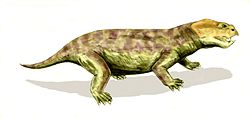Eodicynodon
|
Eodicynodon Temporal range: Middle Permian to Late Permian |
|
|---|---|
 |
|
| Restoration of Eodicynodon oosthuizeni | |
| Scientific classification | |
| Kingdom: | Animalia |
| Phylum: | Chordata |
| Order: | Therapsida |
| Infraorder: | †Dicynodontia |
| Family: |
†Eodicynodontidae Barry, 1974 |
| Genus: |
†Eodicynodon Barry, 1974 |
| Type species | |
|
†E. oosthuizeni Barry, 1974 |
|
Eodicynodon (eo-, early or primitive, dicynodont) is an extinct genus of dicynodont therapsids, a highly diverse group of herbivorous mammal-like reptiles that were widespread during the middle-late Permian and early Triassic. As its name suggests, Eodicynodon is the oldest and most primitive dicynodont yet identified, ranging from the middle to late Permian and possessing a mix of ancestral Anomodont/therapsid features and derived dicynodont synapomorphies.
First described by paleontologist T. H. Barry in 1974, its only associated species, E. oosthuizeni, is named after Roy Oosthuizeni, the South African farmer who discovered the type specimen (a partial skull without the mandible) on his Cape Province farm between 1964 and 1970.
Eodicynodon was a medium sized dicynodont, at about 450 mm long and 150 mm high. While it had many features common to all dicynodonts, such as canine tusks and jaw structures related to the "cheek pivot system" of mastication, is also displayed a number of ancestral features more similar to some of its primitive therapsid relatives.These are listed below.
While the premaxillary bones are fused in more derived dicynodonts, a thin suture extending dorsally up from the palatal facet reveals that they are paired in Eodicynodon, an ancestral feature they share with their primitive relatives Venyukovia, Otsheria, and Pelycosauria.
Simlarly, while the vomers of later dicynodonts are fused, they are paired in Eodicynodon and together with the pterygoid border the intervomero-pterygoidal vacuity; in more derived dicynodonts, this vacuity is more posteriorly located and exclusively bordered by the pterygoid. These features are also present in more primitive relatives of dicynodonts, including Pristerodon, sphenacodont pelycosaurs, cotylosaurs, and Venyukovia.
...
Wikipedia
